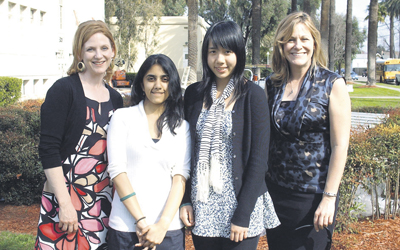By: Allan Ko
On March 4, 2011, sophomores Sonali Toppur and Sherry Xiao won first place in poetry and second place in art, respectively, in the high school division of the 12th Annual Holocaust Art and Writing Contest. This is the second year that English Teachers Katherine Geers and Jennifer Moore have entered their sophomore students in the competition. Chapman University and the “1939” Club, who hosted the competition, awarded $500 to Toppur and $250 to Xiao for their achievements. Toppur will also be taking an all-expenses-paid trip to Washington, DC from June 26-30 to visit the Holocaust Museum and other notable sites.
In the contest, entrants watched a two to three-hour video testimony of a Holocaust survivor, provided by the “1939” Club (named after the year that Hitler invaded Poland) and the Shoah Foundation, two organizations of Holocaust survivors. Based on a prompt established by Chapman University, students were to connect the survivor’s story to their own lives through one of three categories: prose, poetry, or art.
Each participating school chose three entries to send to Chapman University, who selected five finalists in each category and division (high school or middle school) and paid to bring the finalists to the awards ceremony at its campus in Orange, California on March 4. At the ceremony, the first and second place winners in each category were announced and the winners then read or showcased their work to the other finalists and to Holocaust survivors.
At MSJ, Geers and Moore offered the competition to their sophomore students. The contest prompt directed students to reflect on a “space of memory, a place of dialogue between past and present.” Sixty students submitted entries, and a judging panel (consisting of Principal Sandy Prairie, Vice Principal Zack Larsen, Assistant Principals Diana Brumbaugh and Carli Kim, and FUSD Superintendent Jim Morris) selected two pieces to enter (due to a misunderstanding, MSJ sent two entries instead of three). Those two pieces were Toppur’s poem “Protection” and Xiao’s painting “Who’s Saving Whom?” “I’m extremely proud of their work, and I think it’s reflective of their personalities and beautiful spirits,” said Geers, Toppur and Xiao’s English teacher.
Toppur wrote her poem based on the testimony of survivor Eva Safferman, who described how she hid under beetroot leaves to escape deportation twice. Toppur said, “I used my poem to try and express the connection I was able to forge with her, and how struck I was by the fact that a mere beet plant could have the power to save a life. Writing this poem was hard because…I wanted my poem to honor her, not misinterpret her or portray her in a way she would not approve of.”
Xiao watched the testimony of survivor Leon Weinstein, who saved his daughter during the Holocaust by putting her into an orphanage. Xiao says, “In a way…his daughter also saved him by giving him a connection to humanity and an obligation to survive. It reminded me of the way my father and I, despite our fractured relationship, reach out to one another.” Xiao’s painting depicts two people, reaching to each other across a fractured chasm. “Sometimes, you’re out of your comfort zone; reaching over the edge of a metaphorical cliff. In reality, it’s impossible to haul someone single-handedly over the edge, but if we can touch, it’s enough to keep us going.”
Said Toppur, “[Holocaust survivors] share [their testimonies] with us, hoping that someone will be inspired enough…to do something about genocides in the Congo and human rights violations. I walked away from this contest with a newfound sense of empowerment, and the feeling that I can change the world for people just like Eva Safferman.”



I am Eva Safferman’s daughter and would love to read Sonali Topper’s poem. I am very touched that she connected with my mom! Thanks
Lori